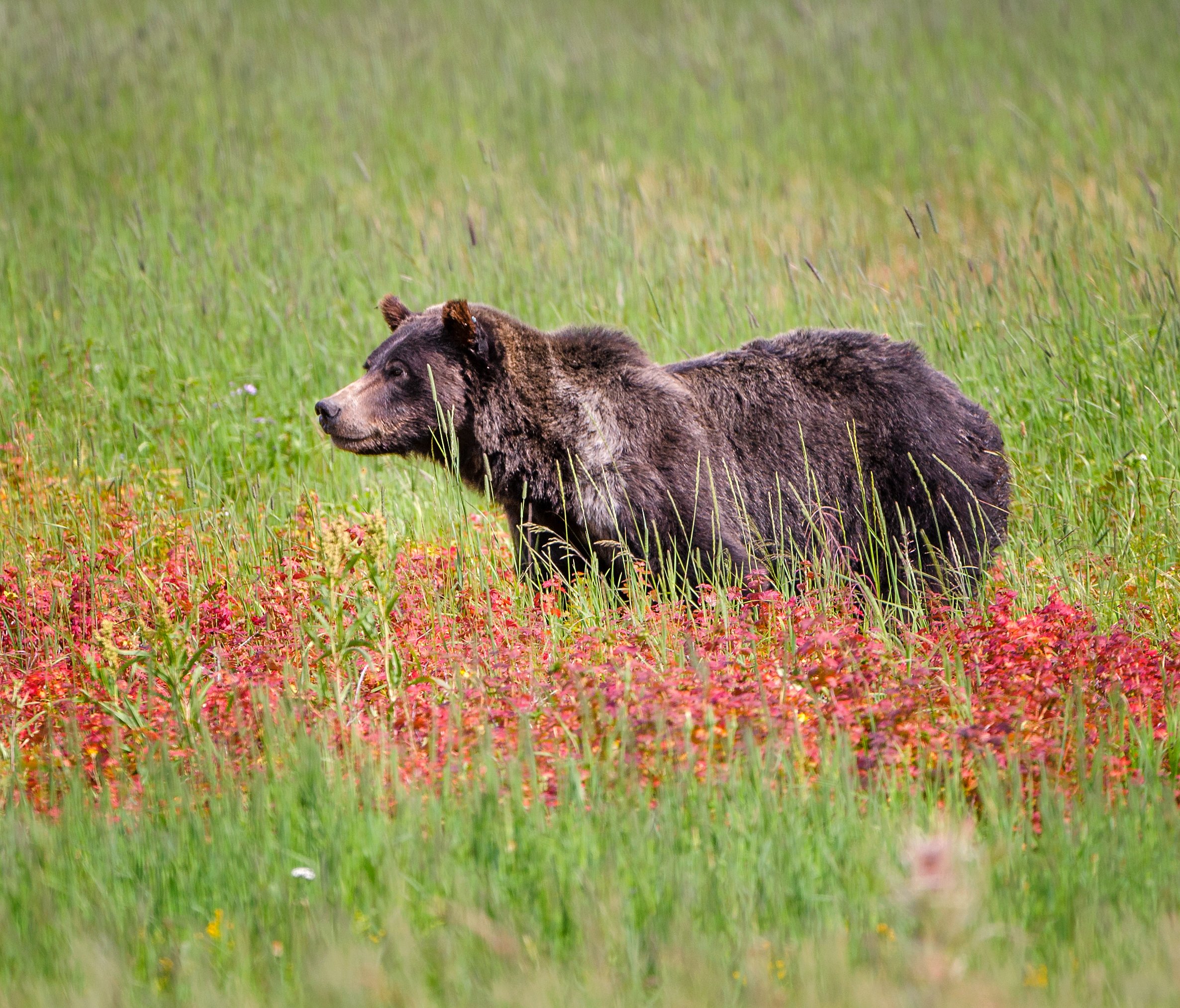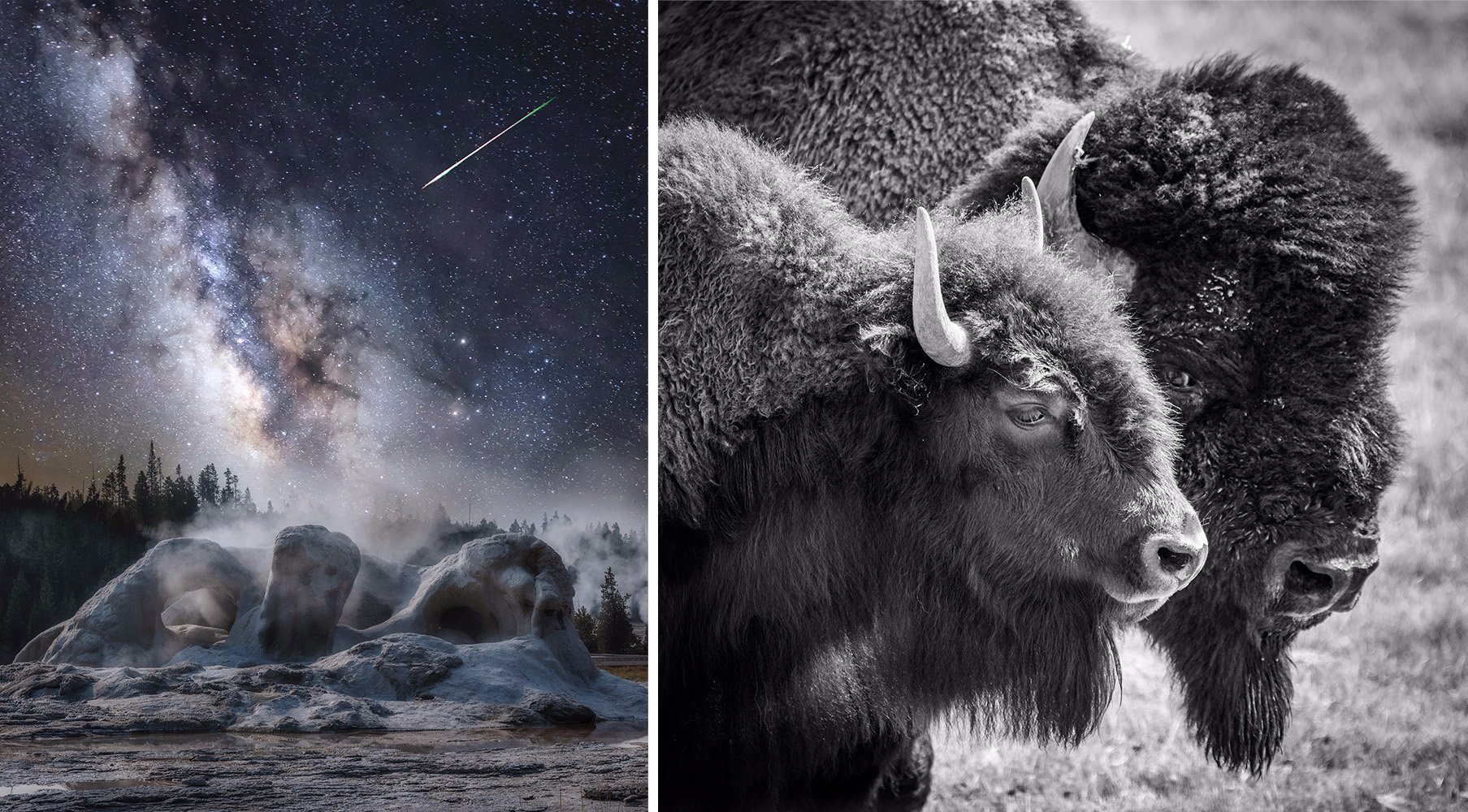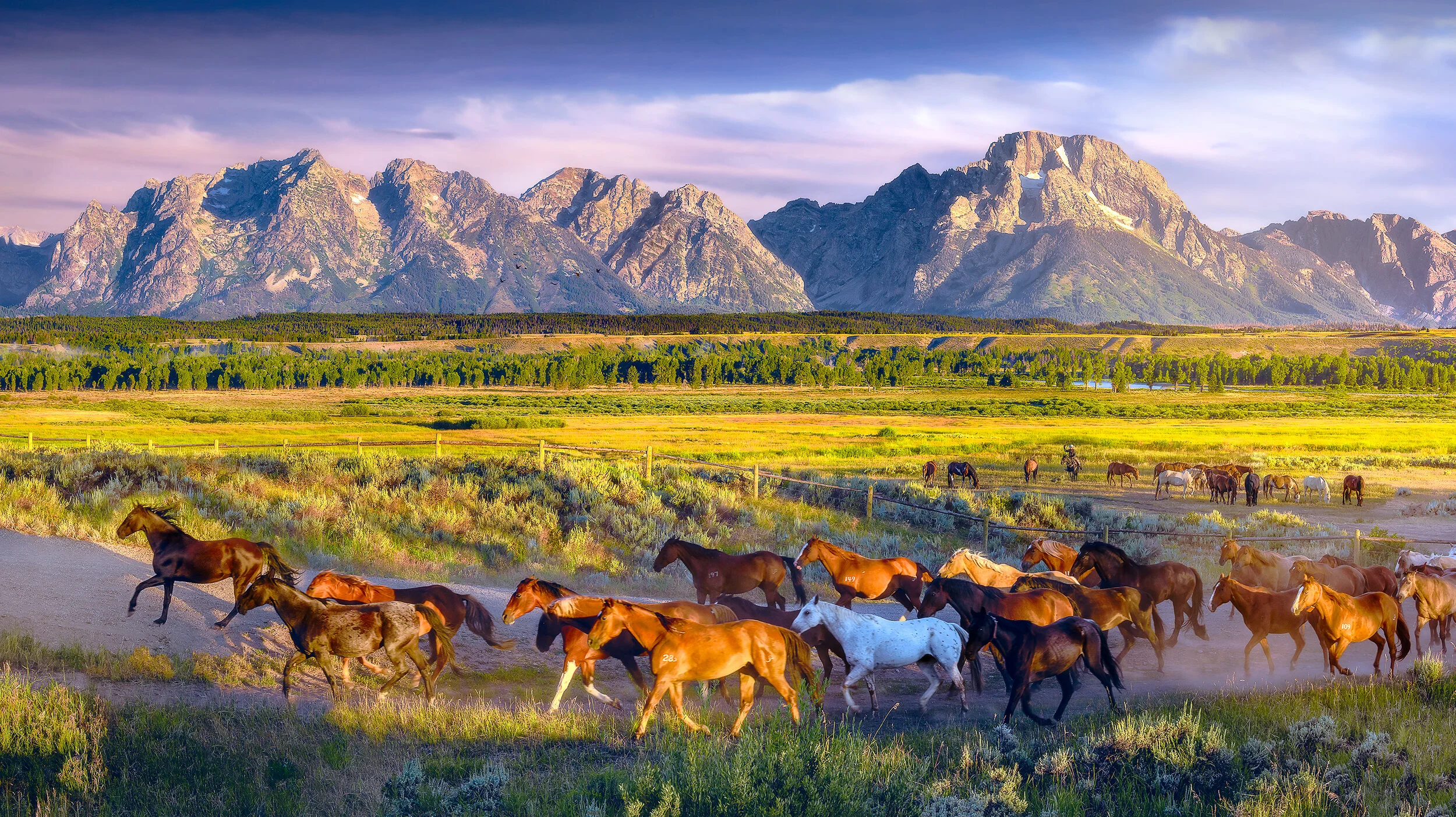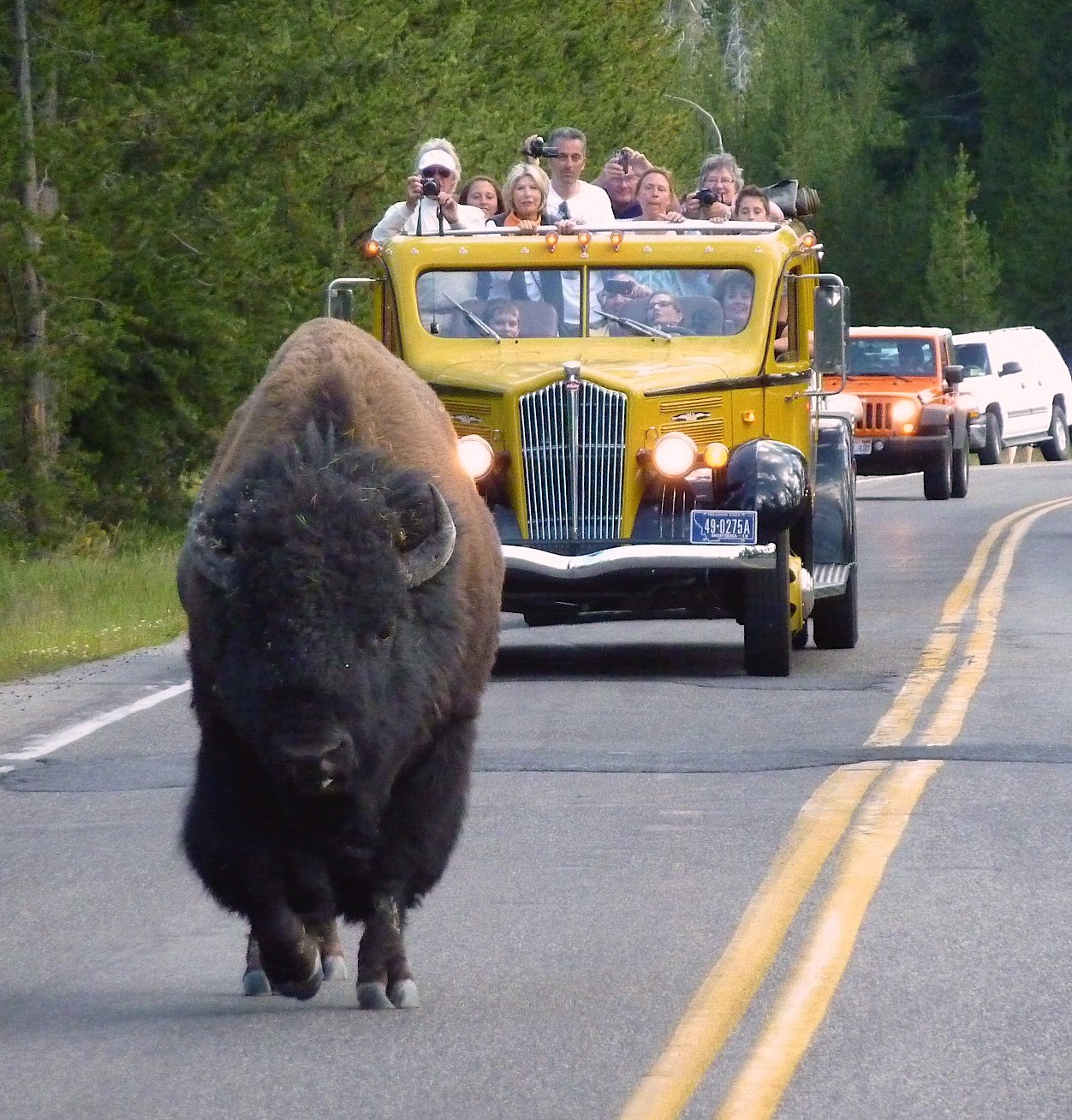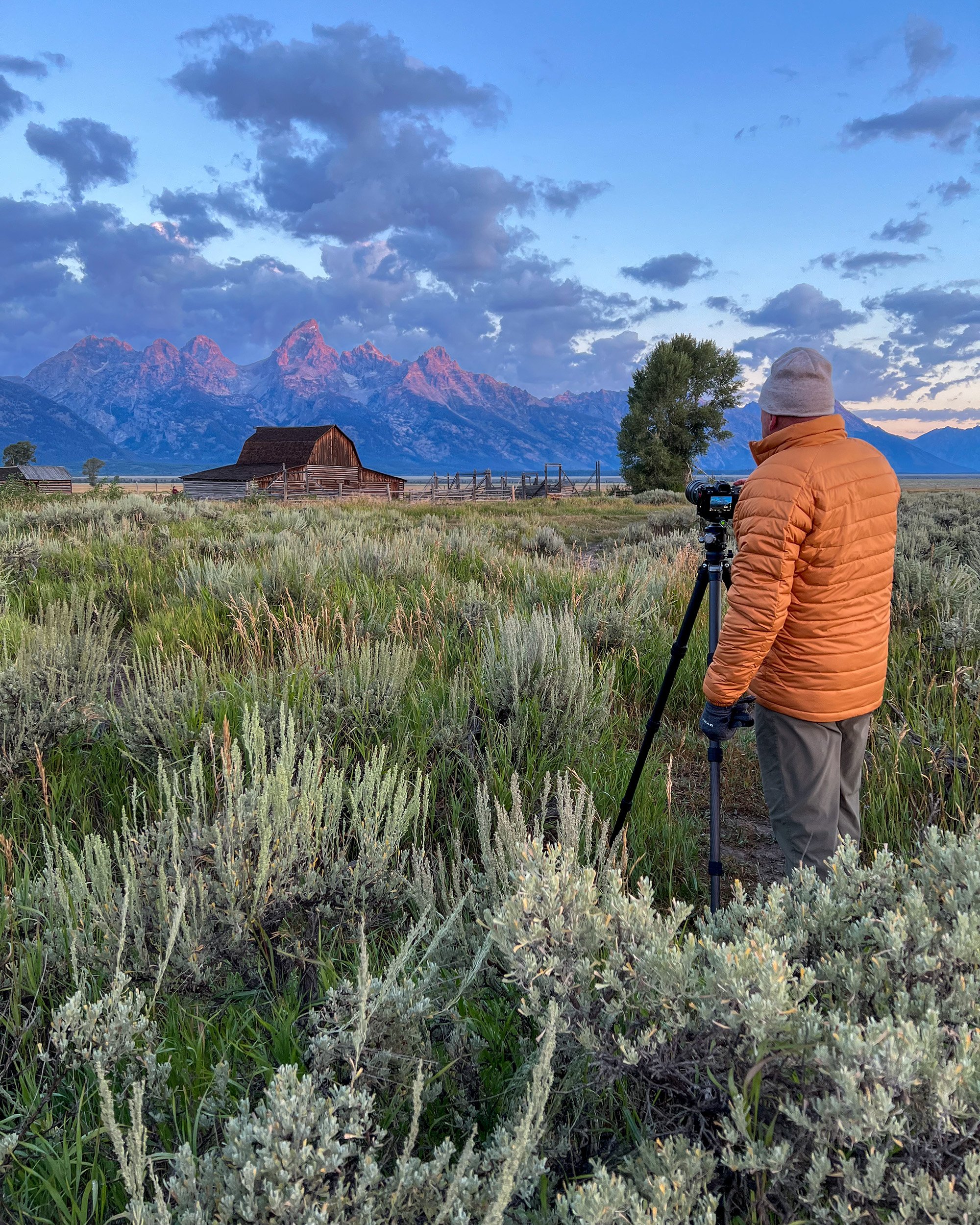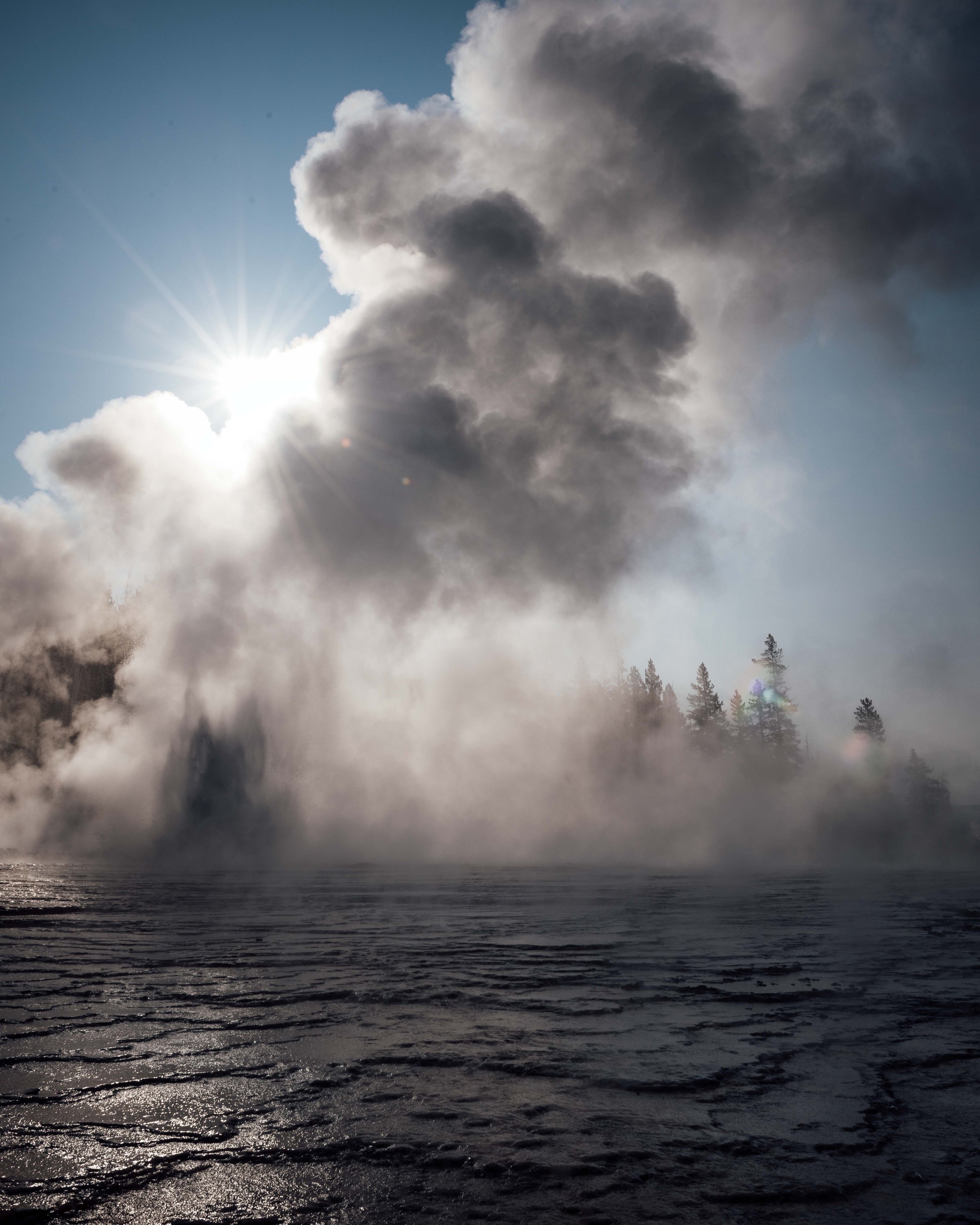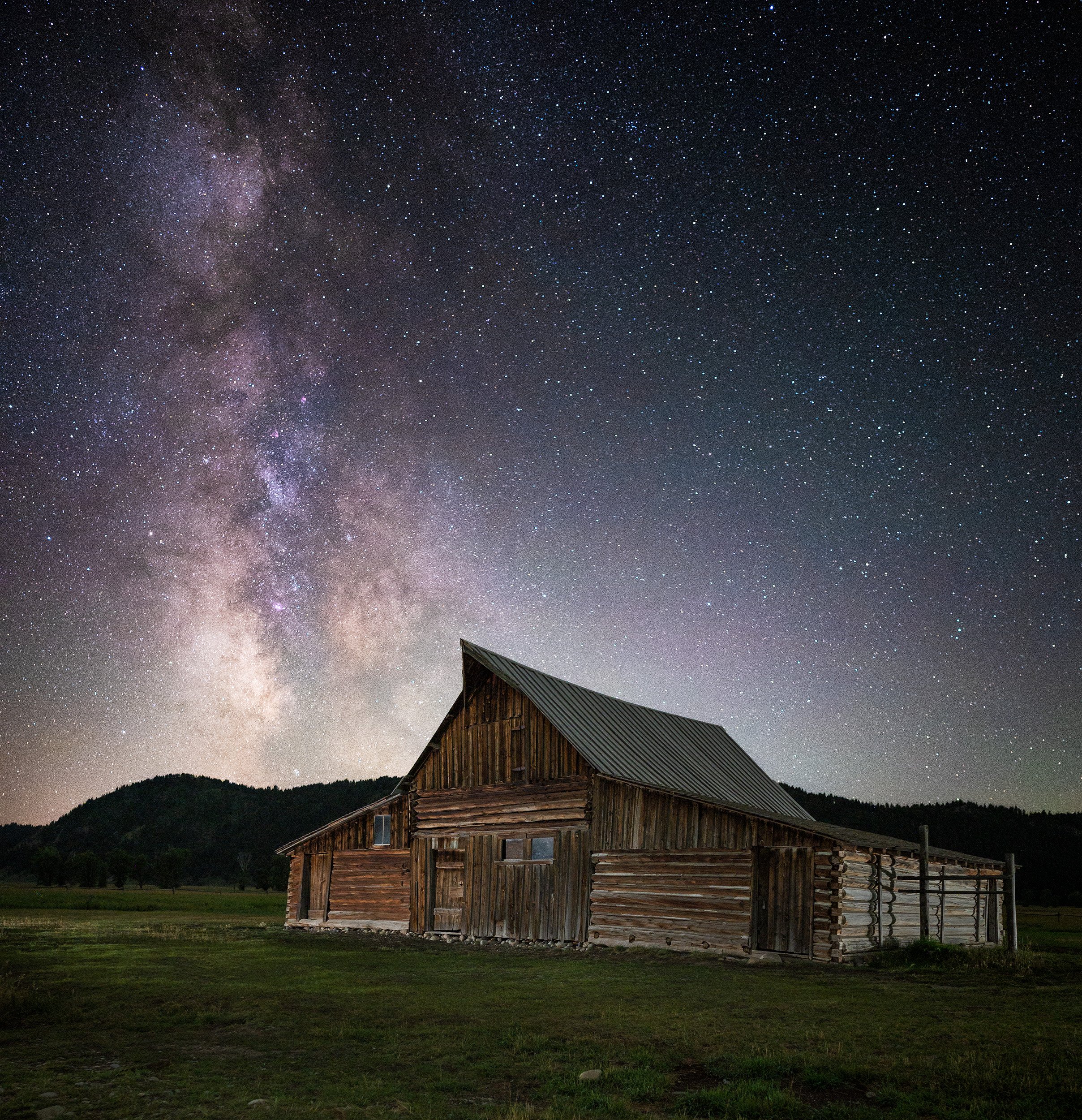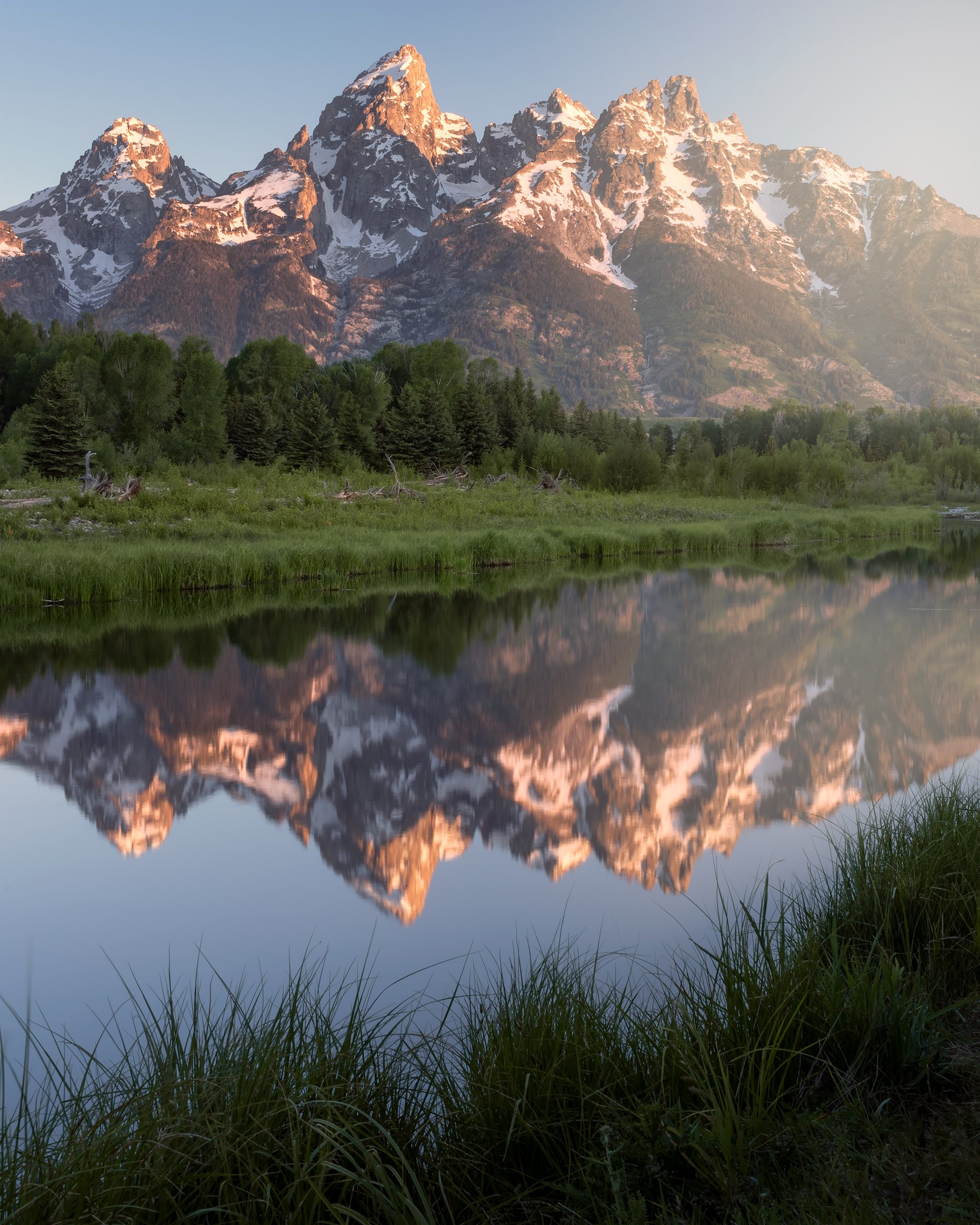
CAPTURE YELLOWSTONE &
GRAND TETONS 2026
6-Day Landscape & Milky Way Photography Workshop
July 13-18 (Monday – Saturday)
Two icons of the American West in One Unforgettable Journey
(Small Group – Five Students)(Private Accommodations Included in Your Booking)
Authorized Permittee of Grand Teton National Park
Venture into the heart of America’s most iconic wilderness, where geysers erupt,, rivers wind through wildflower meadows, and granite peaks knife sharply into the azure skies. We’ll photograph breathtaking landscapes, encounter wildlife, and chase starry skies that stretch endlessly over the open West. This workshop offers a dynamic blend of grand scenery and intimate moments, perfect for photographers ready to deepen their creative voice in a legendary setting.
FEATURES OF THIS TRIP
WHERE WE WILL TRAVEL
Yellowstone National Park
The United States Congress established Yellowstone National Park in 1872, the first preserved area to become a national park. Yellowstone National Park is a roughly 3,500-sq.-mile wilderness recreation area situated atop a supervolcano. The park is located mainly in Wyoming, but also spreads into parts of Montana and Idaho. Yellowstone features dramatic canyons, alpine rivers, lush forests, hot springs and geysers, including its most famous, Old Faithful. Yellowstone is home to hundreds of animal species, including bears, wolves, bison, elk and antelope.
5 Things You may not Know About Yellowstone N.P.
How did Yellowstone get its name? It's named after the Yellowstone River. The river gets its name from the Minnetaree Indians, who called it Mi tse a-da-zi, or Yellow Rock River, most likely from the yellowish formations of the Grand Canyon of the Yellowstone.
Half the world's hydrothermal features are found in Yellowstone: Yellowstone National Park preserves more than 10,000 hydrothermal features — an extraordinary collection of hot springs, mudpots, fumaroles, travertine terraces and—of course —geysers.
“Share the road” takes on a whole new meaning at Yellowstone: Yellowstone is world-renowned for its bison herds. Rush hour here is a little different with bison often causing traffic jams —nicknamed “bison jams.”
Yellowstone is a supervolcano: One of the world’s largest active volcanoes lies beneath Yellowstone. While the volcano is still active, it’s been about 70,000 years since the last lava flow. With the U.S. Geological Survey and University of Utah, the National Park Service established the Yellowstone Volcano Observatory in 2001 to monitor volcanic and seismic activity in the area.
Yellowstone is home to the largest concentration of mammals in the lower 48: Yellowstone’s wildlife is abundant and diverse with an estimated 300 species of birds, 16 types of fish and 67 species of mammals — the largest number of mammal species in the contiguous United States.
WHERE WE WILL TRAVEL
Grand Teton National Park
Grand Teton National Park is located due south of Yellowstone, and was established in 1929, and then again in 1950. In 1929, President Calvin Coolidge approved the original 96,000-acre park, which encompassed the Teton Range and six glacial lakes. In 1943, President Franklin D. Roosevelt established the 210,000-acre Jackson Hole National Monument to protect the remaining federal lands on the valley floor. In 1950, President Harry S. Truman and Congress merged the monument, the national park and a 35,000-acre donation from John D. Rockefeller to create the 310,000-acre Grand Teton National Park we visit today.
3 Things you may not know about Grand Teton N.P.
Earthquakes gave rise to the 40-mile-long Teton Range, which sits on a fault line.
Eight peaks towering above 12,000 feet exist within the park. The highest peak, the Grand Teton, rises 13,770 feet above sea level.
A wide variety of birds flock to Grand Teton National Park. Birders can find avian species of all shapes and sizes, from the trumpeter swan (the largest waterfowl in North America) to the calliope hummingbird (the smallest bird species in North America) in the park.
Before You Book Your Trip,
Sign Up with the K-Group for FREE
It Will Save You Money on This Workshop!
Allow Me to Introduce Myself
It is my privilege to share with you my knowledge of photography, which was instilled during my childhood by my late father and mentor, Lowell Anson Kenyon, Chief of the Office of Photography for the Smithsonian Institution.
My style is upbeat, and enthusiastic, and l provide a positive learning environment that nurtures your art, and grounds you in best practices through personalized instruction. My tips and time-tested techniques will help you pursue your brand of photography with greater purpose and with more intentional creativity.
I hope to share with you my passion, not only for capturing compelling photographs, but also for allowing yourself to be “captured” by the beauty and awe of this place – to connect with nature, and appreciate the relevance of our great western treasures.
These workshops are adventurous, and you will enjoy maximum time in the field.
There is no arguing that golden hour light is wonderful, but you will also learn how to maximize any lighting scenario, simply because we don’t always have the luxury of creating images in golden hour, or under perfect light for that matter. You will also be encouraged to use all of your lenses, whether that be a macro for Autumn still life compositions, or a telephoto to capture intimate landscape details otherwise far from view. Remember, you can always rent lenses if you don’t already own them.
To ensure you receive a well-rounded educational experience, following this workshop, I provide you with two-hours of HD video content from my Digital Darkroom series. The series is suitable for all skill levels in post processing, and use both Adobe Lightroom and Photoshop. If you are uncomfortable with Photoshop, please know there will be content processed solely in Lightroom.
So join me on Capture Yellowstone–Tetons, where filling you with memories is as important as filling your memory cards with unforgettable images.
Trip Overview
n July 2026, we’ll roam Yellowstone’s wild valleys and Grand Teton’s soaring peaks, capturing everything from dramatic landscapes to incredible wildlife.
By night, we’ll turn our lenses toward the night skies, and photograph Milky Way splendor with geothermal features. Join us for a summer adventure where every sunrise and starry night tells a new story.
-
Workshop Snapshot
DATES: July 13-18 (Monday-Saturday); six days under dark skies
PRICE PER PERSON: $3,995 (Includes all lodging) Deposit of $1,995 to hold your place, with final payment due approximately 120 days prior to the trip.
GROUP SIZE: Limit 5 students
PHOTOGRAPHY LEVEL: Beginner-Advanced
TERRAIN: Gradual slopes, uneven and rocky terraine
ALTITUDE: 6,500–8,000’
ACTIVITY LEVEL: Moderate activity with treks under two miles
CLIMATE: Avg. Daytime temps: 70-77˚–– Avg. Nightime temps: 39-43˚
NEAREST TOWN(S): Jackson, WY, West Yellowstone, MT
AIRPORT(S): Jackson Hole, West Yellowstone
VEHICLE: All locations are accessible in passenger cars, with average or higher ground clearance
ACCOMMODATIONS: Your lodging is reserved at Colter Bay Cabins 7/13-15; Yellowstone NP:Yellowstone Lodge in West Yellowstone 7/15-17, Ascend Hotel, Gardiner, MT 7/17-18. Please reference Christine Kenyon Workshop at check in.
Itinerary SnapshotTRIP VITALS: We will kick things off with a Meet & Greet on Monday, July 13, at 2:00 p.m., at Colter Bay Village. We spend two full days (7/13-15) in the Tetons, and then head north on Wednesday (7/15) to our accommodations in West Yellowstone. The remaining three days will be spent in Yellowstone. We will relocate to Gardiner, MT on 7/17. On Saturday morning, 7/18, we will wrap things up, and say our goodbyes after shooting sunrise in Yellowstone. Detailed itinerary is emailed to you approximately 30 days prior to our start date
SHOOTING SCHEDULE: Our featured locations are generally within an hour of our accommodations. Plan to rise early for sunrise on select mornings. Be sure to dress for the temps, bring snacks, and stay hydrated!
LODGING: Grand Teton NP: Your reservation awaits you at the Yellowstone Lodge in West Yellowstone, group cabins at Colter Bay Cabins, and one night at the Ascend Hotel in Gardiner, MT. I have booked two, two-room cabins, with four double beds in each cabin, at Colter Bay Village. These cabins include a private bathroom. If you require individual accommodations, please inform me as soon as possible, so I can check on availability. There will be a surcharge to add a private cabin. Cabin availability is limited. Please reference Christine Kenyon Workshop at check in.
Astronomical Snapshot (Approximate)MORNING
Blue Hour: 5:08 a.m. - 5:23 a.m.
Golden Hour: 5:23 a.m. - 6:28 a.m.
Sunrise: 5:44 a.m.EVENING
Golden Hour: 8:24 p.m. - 9:30 p.m.
Sunset: 9:10 p.m.
Blue Hour: 9:30 p.m. - 9:44 p.m.
Milky Way: 11:30 p.m. - 3:23 a.m.
YELLOWSTONE & GRAND TETONS 2026
July 13-18 (Monday – Saturday)
Six Day Landscape and Milky Way Photography Workshop
$3,995 includes lodging
(Only a deposit required if booked 120+ days in advance)
FAQ
-
This Workshop Includes
I love sharing my knowledge of photography, and I trust these amazing places will inspire you. So come and enjoy an exciting, educational, and fun western adventure, all the while knowing that I am there to guide you through each photographic opportunity.
PLEASE NOTE:We will schedule apre-trip Zoom meeting approximately 30 days prior to the workshop start date
Workshop Instruction to IncludeI will guide you through my workflow in the field, the art of approaching the scene, compositional techniques, scouting and strategy, and some creative philosophy to help you elevate your photography to new heights. From scouting and planning using my recommended phone apps, to my complete Milky Way workflow in the field, you will come away equipped with the knowledge, creative insight, and practical applications to achieve your goals.
Instructional Nightscape Guide
You will receive, via email, my “Capture the Night” guide to nightscape photography (PDF). This guide will review camera setup and settings that optimize your photography for both daytime and night photography.
Digital Darkroom InstructionAt no additional charge, each workshop includes a two-hour post processing Zoom session for the group in approximately two to three weeks following the trip. All attendees are encouraged to attend, as we will go through my Milky Way blue-hour-blend workflow. Every effort will be made to accommodate your schedule when we schedule our session. Should you be unable to attend, you will receive an email with the link to an HD video download of the session.
-
What to Bring
GEAR
Camera: DSLR or mirrorless with a wide aperture (i.e., f/2.8 or wider) lens.
Lenses: Wide angle: 14-24mm, Mid-range: 24-70mm, Telephoto: 70-200mm, 80-400mm, etc.(as noted in full frame focal lengths)
Solid tripod and head
Wired shutter release or wireless remote release, for long bulb-mode exposures (if camera is not equipped)
Extra batteries for everything that takes batteries. You’ll thank me.
Extra memory cards, so you don’t miss a single shot
Lens cleaner/blower to save you from dust gremlins
Circular Polarizer (if you only have one filter in your bag, this is it)
3-stop or variable neutral density (nice to have, but not required)
Laptop, or other system to backup your images each day
PERSONAL
Headlamp (did I say bring extra batteries?)
Camera bag + rainfly (yes, even in the desert)
Bring layered, warm, breathable, clothing, including a waterproof shell
Comfortable supportive footwear, wicking socks (wool or synthetic) (keep your feet happy)
Dress for the temps. Layers are recommended. Always check the local forecast as it varies.
Bring snacks and stay hydrated (hydration especially important at altitude)
Consider hand warmers for those early morning shoots, plus warm gloves or fingerless mittens
Trekking poles (better safe than sorry)
Bug repellant (highly recommend Picaridin by Sawyer for the local DEET-resistant night gnats)
Sun Glasses, hat, handkerchief (Desert sand especially hard on the eyes, handkerchief for dusty wind)
Toiletries
-
This Workshop Does Not Include
No ground transportation, or transportation to or from the workshop.
No food/beverages will be provided
There is no insurance provided to cover your travel, trip, your gear, or your vehicle. (Trip insurance is recommended)
No camera gear is provided
There may be little or no cellphone coverage in the workshop locations
-
Requirements
You are responsible for knowing your way around your camera and its menu system. My time with each of you will be spent learning to capture great images. Please do not burden others, and get less out of this event yourself – know and practice your camera, especially if you will be using any new gear on this trip.
Ability to shoot in a variety of weather and environmental conditions from bright sun to summer storms and at elevations ranging from near sea level to over 10,000 feet in elevation, depending on the workshop.
The ability to hike one to two miles per day over uneven, hilly, and at times rough terrain, however, most locations do not involve much hiking at all.
The ability to remain flexible to make the most out of the often changing environmental conditions.
The ability to work well with others in a group setting.
Our group must stay together. Please do not wander off without telling me of your where abouts. We will be in areas with potential hazards that include exposed cliffs, unstable terrain, and wildlife.
You are responsible for knowing and following all park or jurisdictional rules. Leave No Trace. Let’s leave it better than it was! Thank you!
-
With Christine Kenyon's unmatched cancellation policy, your workshop investment remains secure and flexible. If you're unable to attend, you may receive a refund (if your seat is filled), or apply your payment as a credit toward future workshops for up to two years—giving you peace of mind and full control over your plans.
Refunds and Credits
Should you cancel your trip for any reason, you will receive a full refund, minus a $250 cancellation fee, provided your seat can be filled prior to the workshop commencing. However, there is no guarantee that your seat will be filled.
If your seat cannot be filled, your deposit (for non-custom group workshops only) may be applied as a credit toward another workshop within the same calendar year, minus a $250 cancellation fee, provided a seat is available. If any portion of your credit remains unused, up to 50% of the balance may be carried over for use in the following year. All remaining credit expires after that time. Should the credit be used toward a workshop of greater value, you are responsible for the difference.
In the event of more-than-one cancellation within the two-year credit window, all remaining credit, including any additional payments toward the second cancellation, will be forfeited. We strongly encourage clients to confirm availability and commitment before rescheduling.
All workshops purchased using a cancellation credit are not eligible for any other discount. After the credit is applied to a new workshop, the remaining balance due is to be paid in accordance with the standard trip payment schedule.
Should cancelling a workshop, at any time prior to its commencement, result in Christine Kenyon incurring any nonrefundable costs or fees (i.e., group accommodations, AirBNB, third party bookings, etc.), Christine Kenyon will deduct these costs from any existing credit applicable toward future bookings.
Cancellation requests must be made in writing - via mail or email. No refunds will be given for any delays or cancellations for reasons of inclement weather, cancelled or delayed flights, or other events/disasters, acts of God, or for any circumstance beyond Christine Kenyon’s control, either before, during, or after the workshop.
Trip/travel insurance is highly recommended, and a reference can be provided.




